Part 1: Evidence and Reflection on My Learning
Outcome 1:Describe the potential of human-centered learning in distributed and open learning contexts
Throughout the course, I did some activities and readings that developed in meeting this outcome.
In Topic 1, I discuss the article by Vaughan, Garrison, and Cleveland-Innes, “Teaching and Learning in Blended Learning Environments. Creating and Sustaining Communities of Inquiry” (Vaughan et al., 2013). The author discusses and researches blended education and lists its requirements and basic principles for the teaching and learning environment. I also agree with the authors who mention that ‘simply adding online components does not necessarily meet the threshold for blended learning as defined here’ and ‘the key is to avoid at all costs simply adding activities and responsibilities until the course is completely unmanageable and students have no time to think about the meaning and engage in discussions to gain common understanding’ (Vaughan et al., 2013).
In my posting 1, I mentioned that blended learning models are often present in the learning we experience. It has principles and concepts about encouraging connections between students and teachers, active learning, and a focus on time on task are even more used in many courses educationally, even those in other instructional models. So I think blended education may become a mainstream form of education.
My pod member agrees with me, but he believes that this model of teaching is not applicable to everyone, especially the education of children.

In my Tpoic 2, “Teaching Online – A Guide to Theory, Research, and Practice.“ (Major, C. H.,2015). The authors present a taxonomy chain of online course structures and MOOCs (Massive Open Online Courses) and offer a perspective on how to distinguish fully online courses. I was interested in the author’s discussion that “the most accurate approach is to call courses that never meet onsite fully online, and courses that have some onsite meetings and some activities via the Internet hybrid courses.”(Major, C. H.,2015) This phrase was misunderstood. In fact, both the authors and I believe that even fully online courses require a certain number of course activities and online meetings to help the instructor keep track of the learners’ progress. And I believe that having more course activities is also effective in increasing the popularity of such courses.
Shallow and Keifer, members of my pod learning group, agreed with me and offered their thoughts on the definition of MOOCs and course activities.


In my topics 3 and 4, “ A guide to making open textbooks with students”(Mays, E. (Ed.). 2017) and “ Defining OER-enabled Pedagogy” (Wiley, D. & Hilton, J. 2018) , both readings mention OER and OER, and their views on OER and OER are very similar. In particular, in the reading “A guide to making open textbooks with students” in Topic 3, the authors state that “higher education should be equally accessible to all”. I agree with this statement, and I think that the emergence and promotion of OER can effectively help more students to reduce their burdens and thus better complete their studies.
My pod study group members Lucas and Shallow agreed with me and provided their own perspectives on OER and the open learning approach in the comments section.


Unlike topic 3, the reading for topic 4, “ Defining OER-enabled Pedagogy” (Wiley, D. & Hilton, J. 2018), refers to ‘renewable assignments ‘ as well as ‘disposable assignments’. I also agree with the authors in the article that ‘disposable assignments’ usually take a lot of time and effort from students and teachers, but lose their value after completion, while ‘renewable assignments ‘ can provide lasting benefits to the broader community of learners. I also believe that ‘renewable assignments’ can help learners become more engaged in their work and increase their interest in the course. My study group member Shallow made a similar point in her discussion of the topic, and I commented on her point as well.Throughout the course, I did reading activities as well as pod projects to help me achieve this outcome development.
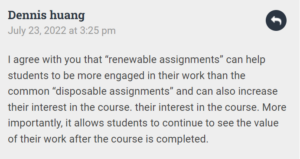
After completing these activities, I learned many new terms such as blended learning approaches, open learning environments, distributed learning environments, open pedagogy, OER, MOOCs, and human-centered learning. I also learned about the structure of online courses, the principles of blended learning, and the differences between open and distributed learning.
This knowledge is important because it is certainly important for a pedagogue to understand the various teaching methods and their pros and cons. And as a learner, I can be more clear about the conditions and abilities needed for various learning methods, such as online courses that require technology platforms to support them; likewise understanding their benefits and drawbacks can help me better plan my future courses and choose the right teaching mode for me.
Outcome 2&3:Explore and engage with current literature on the distributed and open education movement. Critically reflect on and articulate concepts around modality, pedagogy, and access, including distributed and open learning theory, online and open learning history, privacy laws, online learning communities, open research, and open data.
Throughout the course, I did reading activities as well as pod projects to help me achieve this outcome development.
In the Topic 1 discussion, my pod learning team members Keifer and Shallow explored how to ensure that students’ privacy is not violated in the context of learning through big data. Although I did not select that post for discussion, I commented on their post and expressed my belief that more nuanced bills and more reliable regulators may be needed for control.
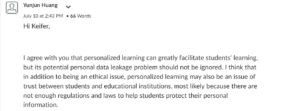
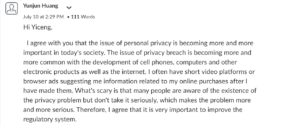
In the discussion of Topic 3, “ A guide to making open textbooks with students”(Mays, E. (Ed.). 2017), the author describes the Open Learning Approach and OER as “equal access to higher education for all”. I agree with the author’s view and I think this is a way for more students, especially those from disadvantaged backgrounds, to succeed. Lucas, a member of my pod study group, had the same discussion and commented on my points and gave his opinion.

In the discussion of Topic 3, the authors also suggest that “learning management systems (Canvas, Moodle, Blackboard, etc.) typically lock students in a closed state It perpetuates a supervised education model in which the instructor perpetuates a supervised model in which the instructor is able to consider metrics that are inaccessible to students; it assumes that all student assignments are disposable (because all assignments are removed when a new course shell is introduced the following semester).” (Mays, E. (E.), (2017)). This is a good write up of the difference in technology platform requirements between a distributed education environment and an open education environment, also as an online course. I also mentioned in the posting that there are many similarities between distributed and open education environments. In particular, distributed asynchronous learning and open learning have almost the same impact on students in many cases, and the differences between them are harder to detect than in other teaching environments. This is also reflected in our pod project.
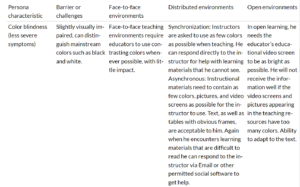
In the OUTCOME 1 section, I have mentioned the thoughts and discussions the authors and I had in TOPIC 1 , and 2 about the principles of blended learning, and the structure of online courses and MOOCs. “Teaching and Learning in Blended Learning Environments. Creating and Sustaining Communities of Inquiry” (Vaughan et al., 2013), and “Teaching Online – A Guide to Theory, Research, and Practice.“ (Major, C. H.,2015). My instructor for this course also gave comments on my posting and pointed out many errors in my understanding of the article.
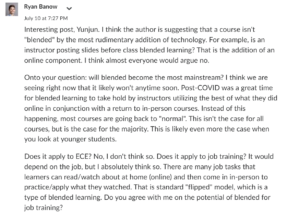

By completing these activities, I learned about the difference between distributed and open education, the principles of blended learning, and the structure of online courses and MOOCs.
This knowledge was important because they allowed me to understand the intent of some of the arrangements that many instructors make in the teaching process and how these arrangements can help students. I also understood how to better integrate various learning methods.
Outcome 6: Practice digital, networked, and open literacies in support of learning about distributed and open learning
Throughout the course, my group members and I communicated online through various software to achieve the development of this outcome.
We post links to our own posts and projects through the Mattermost software group channel and receive feedbacks on our projects from instructors.
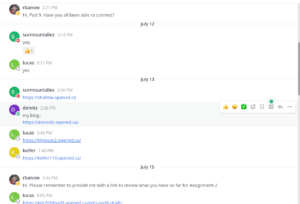

After that, we found out that our group members are all from China, so we communicate with each other through WeChat when we are working on our project.
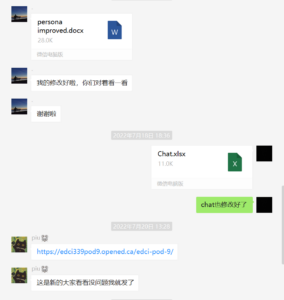
By completing these activities, I learned that it is equally possible to have discussions and complete group projects through online communication platforms and social networking software.
What I learned was important to me because it greatly reduced the amount of time we spent traveling for offline meetings, and we were able to schedule our meetings more freely.
Reflection: After completing this course, I found many inadequacies in myself. First, after the comments I received on my postings, I usually read them and then did not respond, which I think limits my communication with others. This is a problem I need to be aware of and correct. Secondly, I sometimes misunderstand some of the sentences that appear in the posts, which I think is probably due to my lack of patience in reading the posts. I often discuss the article as I first think after reading it, but I do not read it several times to fully understand the meaning of each sentence, which is also a problem worth noting. Finally, I think I learned a lot through this course, including the principles of various learning environments and how they are structured. Not only that, but I also learned how to use wordpress, how to post my own posts through it, and how to complete projects, which I think will be very useful knowledge and skills for my future courses and for my future work.
Part 2: Showcase
Link to updated version of the post: https://dennish.opened.ca/showcase/
Link to the original version of the post:https://dennish.opened.ca/topic-3-open-pedagogy/
Description of the changes made along with reasons why the changes were made:
In the first paragraph, I have added to the author’s viewpoint and corrected some grammatical errors.
Added my thoughts on OER and what it stands for and discussed how their promotion has helped students.
Some personal perspectives are added at the end, discussing the impact of OER promotion on open pedagogy and the potential of open pedagogy.
Reference:
Major, C. H. (2015). Teaching Online – A Guide to Theory, Research, and Practice. Retrieved from http://ebookcentral.proquest.com/lib/uvic/detail.action?docID=3318874 (pp. 76-108)
Mays, E. (Ed.). (2017). A guide to making open textbooks with students. Rebus Community. Chapter 1: Open Pedagogy : https://press.rebus.community/makingopentextbookswithstudents/chapter/open-pedagogy/
Vaughan, N. D., Garrison, D. R., & Cleveland-Innes, M. (2013). Teaching in blended learning environments: Creating and sustaining communities of inquiry. AU Press. https://read.aupress.ca/read/teaching-in-blended-learning-environments/section/ac46044a-ecde-4fc4-846d-8c17fe8bf712
Wiley, D. & Hilton, J. (2018). Defining OER-enabled Pedagogy. International Review of Research in Open and Distance Learning, 19(4).
Leave a Reply